Imagine stepping into a living room where the scent of aged wood mingles with the warmth of a flickering fire, and every corner feels like a story from a countryside postcard. That’s the beauty of rustic decor — it’s not just a style; it’s an experience.
Rustic interiors remind us of a simpler life — one filled with handmade furniture, natural textures, and timeless charm. But when it comes to modern living rooms, one question often arises: How do you create distinct zones without losing that cozy, open feel?
Zoning isn’t just for large spaces; even a compact rustic living room can benefit from thoughtful layout planning. It helps balance aesthetics with functionality — whether you’re blending a reading nook into your lounge area or creating an intimate dining space within an open-plan setting.
So, if you love farmhouse comfort, wooden tones, and organic textures, here are 8 rustic living room zoning ideas that blend countryside charm with clever design flow.
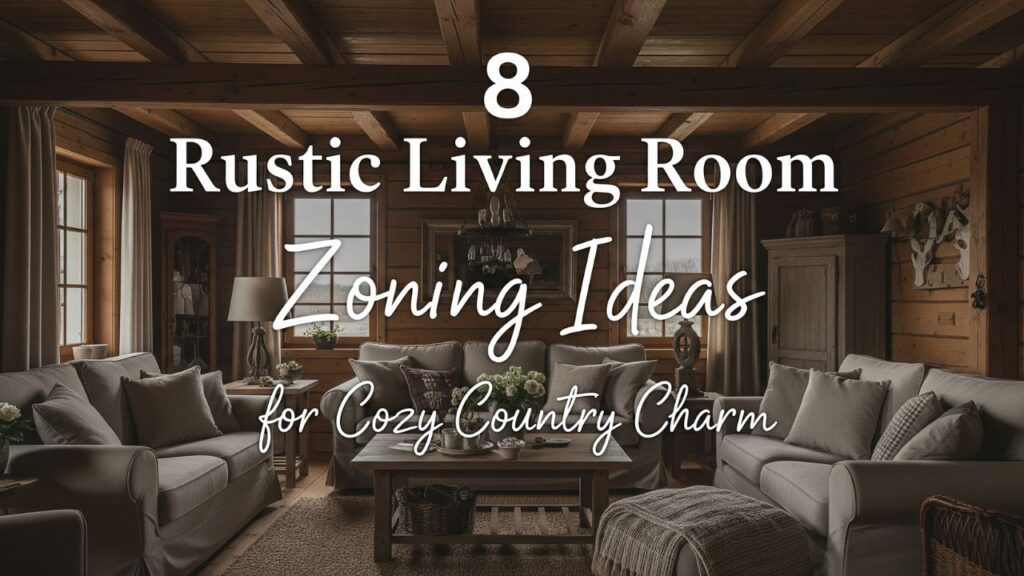
Table of Contents

8 Best Rustic Living Room Zoning Ideas
1. Use Area Rugs to Define Spaces

One of the simplest and most effective ways to zone a rustic living room is with area rugs. They help visually separate areas like the seating zone, reading nook, or dining space without the need for walls or dividers.
Opt for woven jute, hand-knotted wool, or patterned kilim rugs to complement rustic aesthetics. Layering rugs can add depth and dimension — for example, placing a smaller patterned rug over a large neutral one gives warmth and personality.
Interesting fact: Did you know that in early rural homes, rugs were a luxury, often handmade from old clothing scraps? These “rag rugs” became symbols of thrift and creativity — values that still inspire rustic decor today.
2. Create Natural Partitions with Wooden Beams or Screens
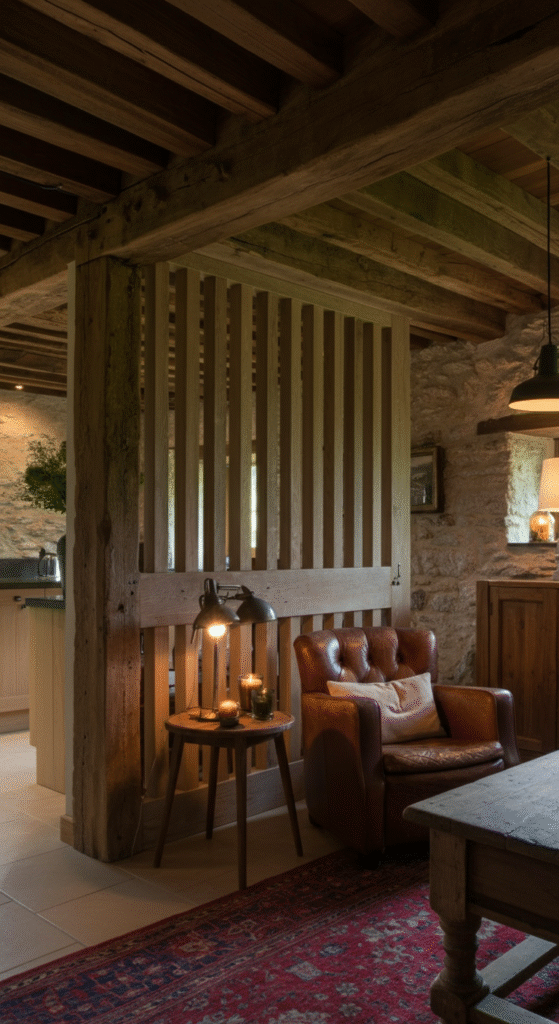
Wood is at the heart of rustic design. To subtly divide your space, use wooden beams, reclaimed timber columns, or slatted partitions. These natural elements maintain openness while offering structure.
A low reclaimed-wood divider can separate a living and dining area, while rustic ceiling beams visually distinguish zones without blocking light. If you prefer flexibility, freestanding folding screens made from distressed wood or rattan add both function and vintage charm.
Do you know? In many traditional barns, wooden beams weren’t just structural — they defined activity zones, from hay storage to workspaces. Today, they carry that same zoning magic into our homes.
3. Arrange Furniture in Distinct Clusters
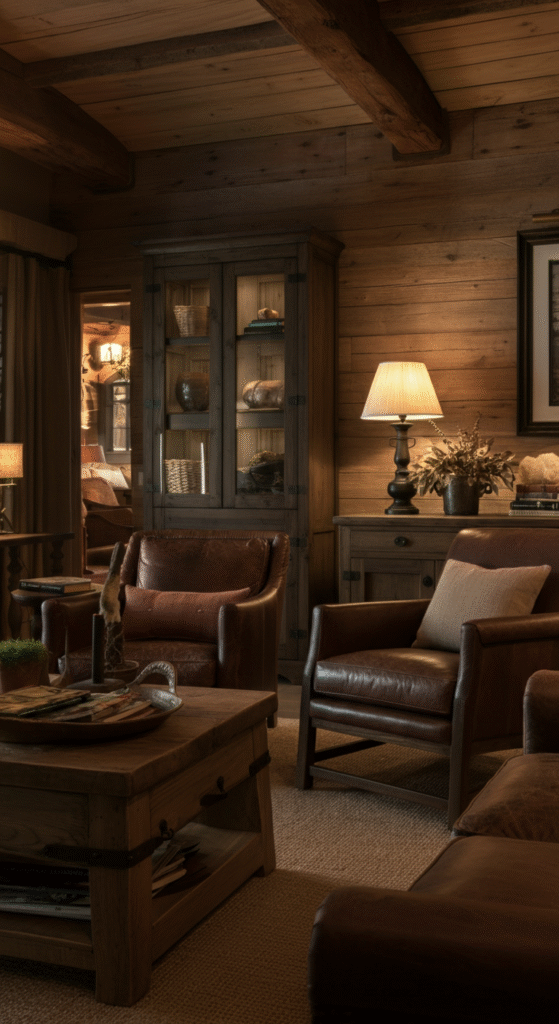
Instead of aligning all furniture against the walls, group pieces strategically to form distinct clusters. Place sofas and chairs around a central coffee table to create a conversation area. A separate corner with a comfy armchair, bookshelf, and lamp can transform into a reading nook.
For rustic interiors, opt for sturdy wooden furniture, tufted leather chairs, or linen slipcovers. Use vintage trunks or wooden chests as coffee tables to double up on storage and texture.
Myth buster: Many believe small living rooms should stick to minimal furniture. In truth, zoning through grouped layouts can make small rustic rooms feel larger and more purposeful.
4. Use Lighting to Define Mood and Function
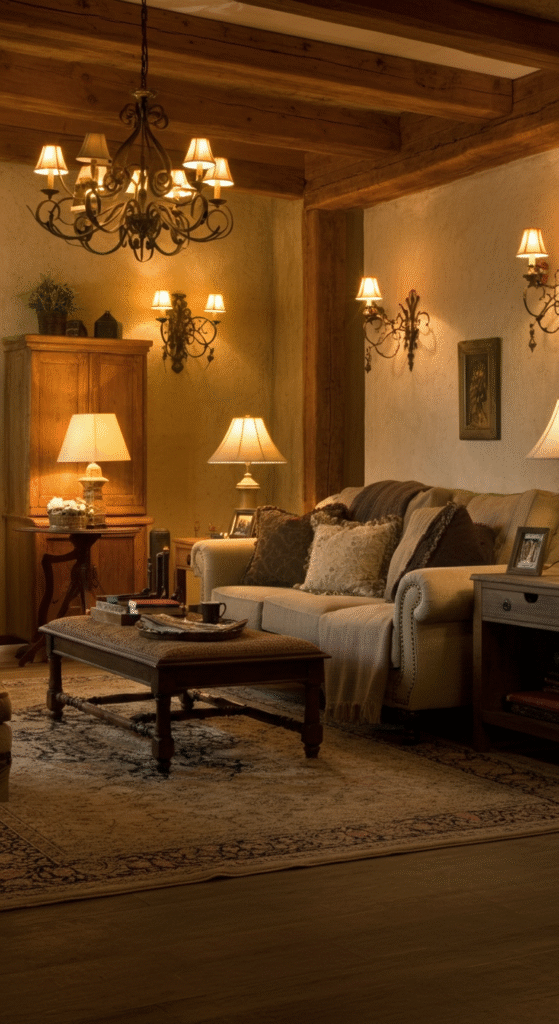
Lighting is the unsung hero of zoning. In a rustic living room, mix different lighting types to mark specific zones — pendant lights above a reading chair, a wrought-iron chandelier over the central seating area, and soft sconces near artwork or shelves.
Choose fixtures that echo rustic character: think aged metal, wrought iron, or mason jar pendants. Warm-toned bulbs are key — they enhance the cozy, golden glow that rustic spaces are known for.
Interesting fact: Before electricity, rustic homes relied heavily on natural light and candle lanterns. That’s why layering light sources today recreates that same gentle ambiance — practical yet deeply nostalgic.
5. Define Zones with Flooring Transitions
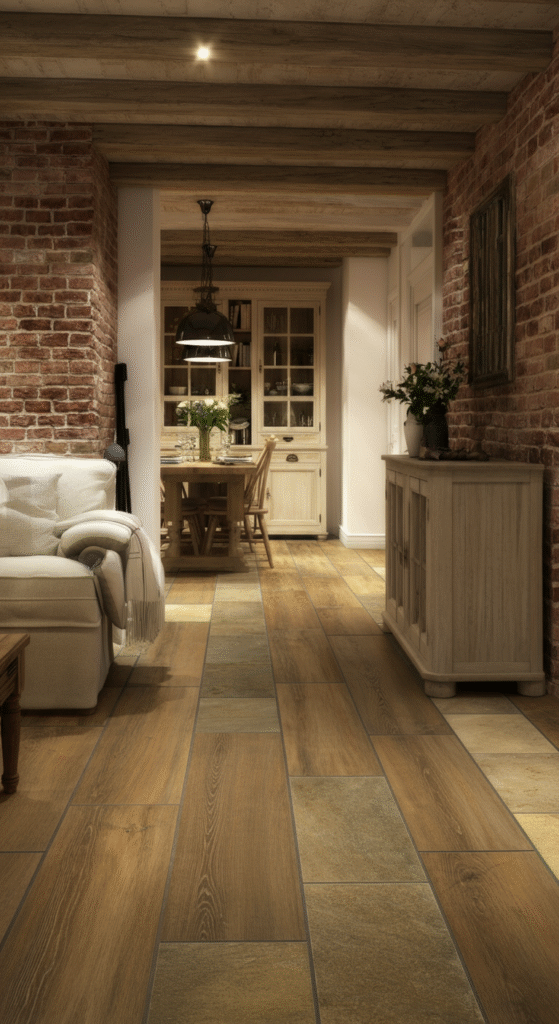
While rugs help soften transitions, using different flooring materials for distinct areas adds a subtle zoning cue. You can use reclaimed wood for the main seating space and natural stone or brick for adjoining dining areas.
For open-plan rustic layouts, a change in flooring texture — from matte wood planks to terracotta tiles — creates visual rhythm and flow. The key is maintaining warm, earthy tones for harmony.
If you prefer a seamless look, use the same flooring throughout but change the direction of planks or add a border trim between zones.
Do you know? In early country homes, different flooring materials were often practical — wood for warmth near the fireplace and stone near the entrance to resist dirt. Today, it’s a beautiful nod to rustic authenticity.
6. Incorporate Furniture as Room Dividers

Rustic spaces thrive on practicality. Use multi-purpose furniture to act as dividers — such as open shelving units, console tables behind sofas, or low bookcases.
An open wooden shelf filled with pottery, baskets, or plants can divide the living and dining zones while maintaining visual connection. Similarly, a console table placed behind a couch defines a seating area without crowding the room.
Try repurposing vintage finds — like an old carpenter’s bench or a reclaimed ladder shelf — to enhance the rustic theme while adding functionality.
Interesting fact: In old farmhouses, furniture was often hand-built to fit specific corners and needs. Repurposing vintage furniture for zoning not only saves space but keeps that tradition alive.
7. Use Greenery to Soften Boundaries

Plants breathe life into rustic interiors. Beyond aesthetics, they can also act as natural boundaries between zones.
Use tall potted plants like fiddle-leaf figs or indoor olive trees to define the edge of your seating area. Hanging planters or trailing ivy between shelves can visually separate spaces without hard lines.
Choose rustic-style containers — terracotta pots, wooden crates, or metal buckets — to maintain consistency. Greenery adds a fresh contrast to the earthy textures of wood and stone that dominate rustic decor.
Do you know? In farmhouse traditions, indoor plants were not just for beauty but served practical uses — herbs like rosemary and thyme were often kept indoors for easy cooking and natural air purification.
8. Highlight Architectural Features

If your living room has natural architectural elements, use them as organic zoning tools. Stone fireplaces, exposed brick walls, or archways can serve as natural focal points to anchor specific areas.
Place your main seating arrangement around the fireplace, or use an exposed brick column as a visual divider. If you have a window alcove or bay window, turn it into a cozy reading nook with layered textiles and cushions.
This approach keeps zoning effortless — it works with the room rather than against it.
Myth alert: Some homeowners think architectural quirks limit their layout options. In reality, they’re your best allies in defining functional and beautiful living zones.
Additional Tips for a Cohesive Rustic Layout
- Stick to a unified color palette: Use warm earth tones, beiges, and deep browns across all zones.
- Mix textures thoughtfully: Combine rough (wood, stone) with soft (linen, wool) for comfort and depth.
- Keep it uncluttered: Rustic decor thrives on authenticity — display only pieces with meaning or craftsmanship.
- Balance light and dark: Use lighter textiles to soften heavy wood tones and maintain a welcoming feel.
- Personalize your space: Add handmade pottery, woven baskets, or heirloom furniture to make each zone uniquely yours.
Conclusion
Zoning a rustic living room isn’t about dividing space — it’s about defining experience. Each zone tells its own story while blending seamlessly into the next, creating a natural flow that’s cozy, functional, and visually grounded.
From layered rugs to reclaimed wood dividers, rustic zoning celebrates craftsmanship and comfort in equal measure. Whether you’re working with a sprawling countryside home or a small city apartment craving rural warmth, these ideas help you achieve that coveted cozy country charm without sacrificing practicality.
In the end, rustic design is all about soul — spaces that feel lived in, loved, and layered with meaning. By thoughtfully zoning your living room, you’re not just decorating; you’re creating a haven that feels timeless, welcoming, and wonderfully yours.
Frequently Asked Questions (FAQs)
How do you zone a rustic living room without using walls?
Use rugs, furniture groupings, or wooden partitions to define zones while keeping the space open and cohesive.
What colors work best for rustic living rooms?
Warm earth tones like beige, brown, cream, and muted greens or grays create a cozy, natural vibe.
Can small living rooms be zoned effectively?
Yes, even compact rooms can be zoned using clever furniture placement and layered lighting to separate functions.
What materials define rustic style?
Natural materials such as reclaimed wood, stone, leather, and linen are key elements of rustic interiors.
How do I make my rustic living room feel cozy?
Layer textures — like wool throws, jute rugs, and wooden accents — and use warm, soft lighting to enhance comfort.










